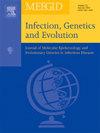马达加斯加艾滋病毒感染者中艾滋病毒-1 基因多样性高,传播耐药性流行率低。
IF 2.6
4区 医学
Q3 INFECTIOUS DISEASES
引用次数: 0
摘要
背景和目标:有关马达加斯加艾滋病耐药性的数据既罕见又过时。在这项研究中,我们评估了马达加斯加对抗逆转录病毒药物(ARVs)产生耐药性变异的艾滋病病毒感染者(PLHIV)的患病率以及循环菌株的遗传多样性:我们按照法国 ANRS 方案扩增了蛋白酶(PR)、逆转录酶(RT)和整合酶(IN)基因片段。我们使用 Illumina 平台(MiSeq)上的新一代测序技术对扩增子进行了测序。我们使用 PhyML 中的最大似然法进行系统发育分析,确定了 HIV-1 亚型。使用斯坦福算法(9.5.1 版)进行耐药性解读:我们纳入了 239 名感染 HIV 的成人和儿童,采样时间为 2019 年 1 月至 2023 年 11 月,中位年龄为 30 岁,平均血浆 HIV 病毒载量为 6.3 Log copies/ml。我们对 239 份样本中的至少一个基因组片段(PR 或 RT 或 IN)进行了测序,但有 9 份样本被排除在分析之外(平均深度 结论):我们的研究结果表明,在马达加斯加成年的接受过治疗的艾滋病毒感染者中,抗逆转录病毒药物耐药性突变的发生率较低。在 15 岁以下的儿童中,92% 是两岁以下的婴儿,耐药率高可能与母婴传播有关。没有发现多鲁曲韦的耐药性突变。我们还观察到高频率的亚型 C、B、A1 和高比例的 URFs,这突显了疫情的持续动态发展。本文章由计算机程序翻译,如有差异,请以英文原文为准。
High HIV-1 genetic diversity and low prevalence of transmitted drug resistance among treatment-naive people living with HIV in Madagascar
Background and objectives
Data on HIV drug resistance in Madagascar are rare and outdated. In this study, we assessed the prevalence of HIV drug resistance mutations to antiretrovirals (ARVs) and genetic diversity of circulating strains in treatment-naive people living with HIV (PLHIV) in Madagascar.
Materials and methods
We amplified the protease (PR), fragments of the Reverse Transcriptase (RT) and Integrase (IN) genes according to the French ANRS protocol. The amplicons were sequenced using next-generation sequencing technology on an Illumina platform (MiSeq). We determined HIV-1 subtypes through phylogenetic analysis using maximum likelihood in PhyML. Resistance interpretation was performed using the Stanford algorithm (version 9.5.1).
Results
We included 239 HIV-infected adults and children, sampled between January 2019 and November 2023, with a median age of 30 years and a mean plasma HIV viral load of 6.3 Log copies/mL. We sequenced at least one genomic fragment (PR or RT or IN) of the 239 samples, but 9 were excluded from analysis (mean depth < 10,000×). Phylogenetic analysis of 230 sequences revealed the presence of subtype C (33.91 %), A1 (11.30 %), B (11.30 %), CRF02_AG (9.56 %), subtype G (3.04 %), subtype D (0.43 %), CRF01_AE (0.43 %), and a significant proportion of unique recombinant forms (URFs) (30.30 %). The prevalence of transmitted drug resistance (TDR) was 4.95 % (10/202) among patients aged 15 years and older. When stratified by ARV class, this prevalence was 4.79 % for non-nucleoside reverse transcriptase inhibitors (NNRTIs), 0.59 % for Nucleoside Reverse Transcriptase inhibitors (NRTIs), and 0.50 % for integrase strand transfer inhibitors (INSTIs). Among children under 15 years old (n = 28), the prevalence of TDR was 14.28 % (4/28), with all mutations conferring resistance to NNRTIs. No mutation conferring resistance to protease inhibitors was found, neither in children nor in adults.
Conclusion
Our results show a low prevalence of ARV resistance mutations among adult treatment-naive PLHIV in Madagascar. In children under 15 years old, 92 % were infants under two years old, the high resistance rate is likely related to mother-to-child transmission. No resistance mutation to dolutegravir was detected. We also observed high frequencies of subtypes C, B, A1 and a high proportion of URFs, highlighting an ongoing dynamic epidemic.
求助全文
通过发布文献求助,成功后即可免费获取论文全文。
去求助
来源期刊

Infection Genetics and Evolution
医学-传染病学
CiteScore
8.40
自引率
0.00%
发文量
215
审稿时长
82 days
期刊介绍:
(aka Journal of Molecular Epidemiology and Evolutionary Genetics of Infectious Diseases -- MEEGID)
Infectious diseases constitute one of the main challenges to medical science in the coming century. The impressive development of molecular megatechnologies and of bioinformatics have greatly increased our knowledge of the evolution, transmission and pathogenicity of infectious diseases. Research has shown that host susceptibility to many infectious diseases has a genetic basis. Furthermore, much is now known on the molecular epidemiology, evolution and virulence of pathogenic agents, as well as their resistance to drugs, vaccines, and antibiotics. Equally, research on the genetics of disease vectors has greatly improved our understanding of their systematics, has increased our capacity to identify target populations for control or intervention, and has provided detailed information on the mechanisms of insecticide resistance.
However, the genetics and evolutionary biology of hosts, pathogens and vectors have tended to develop as three separate fields of research. This artificial compartmentalisation is of concern due to our growing appreciation of the strong co-evolutionary interactions among hosts, pathogens and vectors.
Infection, Genetics and Evolution and its companion congress [MEEGID](http://www.meegidconference.com/) (for Molecular Epidemiology and Evolutionary Genetics of Infectious Diseases) are the main forum acting for the cross-fertilization between evolutionary science and biomedical research on infectious diseases.
Infection, Genetics and Evolution is the only journal that welcomes articles dealing with the genetics and evolutionary biology of hosts, pathogens and vectors, and coevolution processes among them in relation to infection and disease manifestation. All infectious models enter the scope of the journal, including pathogens of humans, animals and plants, either parasites, fungi, bacteria, viruses or prions. The journal welcomes articles dealing with genetics, population genetics, genomics, postgenomics, gene expression, evolutionary biology, population dynamics, mathematical modeling and bioinformatics. We also provide many author benefits, such as free PDFs, a liberal copyright policy, special discounts on Elsevier publications and much more. Please click here for more information on our author services .
 求助内容:
求助内容: 应助结果提醒方式:
应助结果提醒方式:


